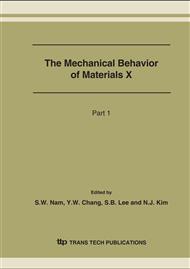p.339
p.343
p.347
p.351
p.355
p.359
p.363
p.367
p.371
Experimental Investigation on the Fatigue Strength of the Replacement Repair Welded Joints
Abstract:
In recent years, the replacement repair welding, which repairs damaged steel girder bridges by replacement of the damaged sections with new steel plates through cutting and welding under in-service conditions, is spotlighted for its brilliant features, i.e. it can be achieved without incurring traffic dislocation. However, the mechanical behavior of the welded joints under cyclic loads due to the traffic which passes along the girder bridges is not clarified. In this paper, the fatigue strength of the replacement repair welded joints was investigated in order to improve reliability in the repair welded joints. Steel plate was extracted from the old steel girder bridge; then was welded with new steel plate to construct specimen with the replacement repair welded joints. Flux Cored Arc Welding (FCAW) process was used to fabricate the double "V" butt joints. Fatigue tests were conducted using a servo hydraulic controlled 50tonf capacity UTM with a frequency of 5Hz under constant amplitude loading. The fatigue strength of the replacement repair welded joints was analyzed in detail.
Info:
Periodical:
Pages:
355-358
Citation:
Online since:
August 2007
Authors:
Price:
Сopyright:
© 2007 Trans Tech Publications Ltd. All Rights Reserved
Share:
Citation:


